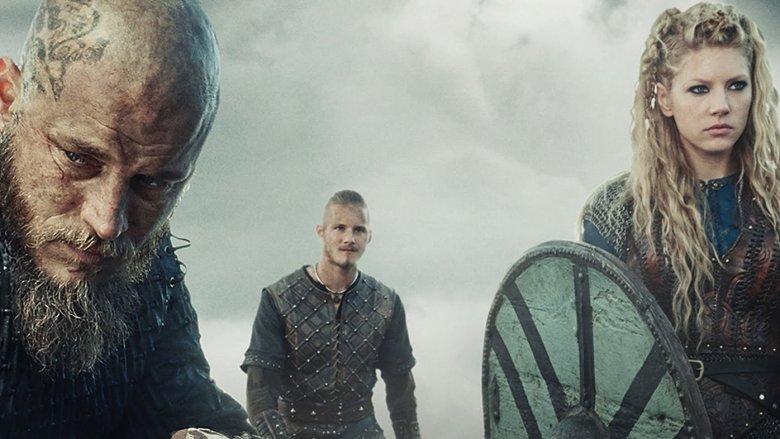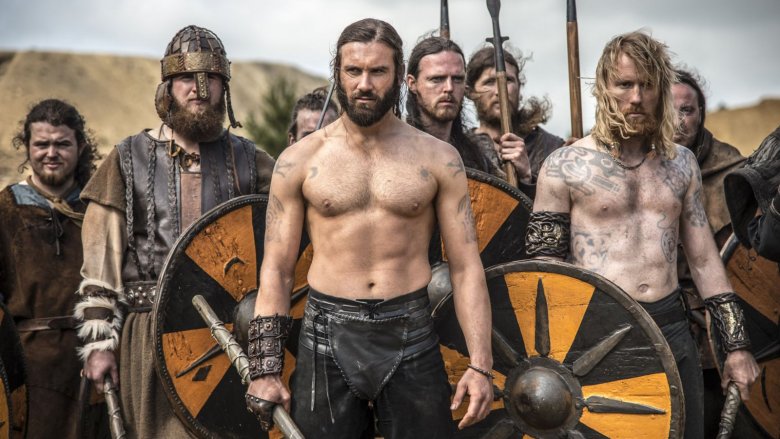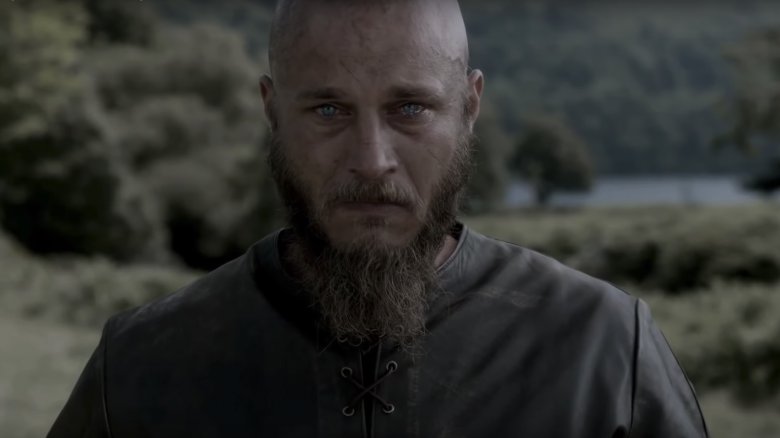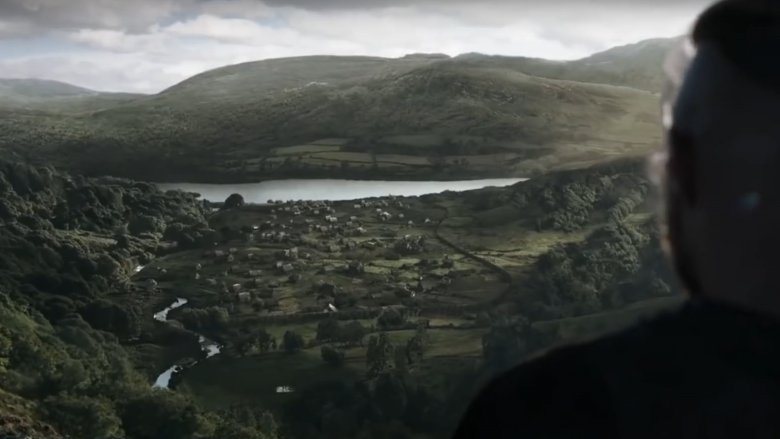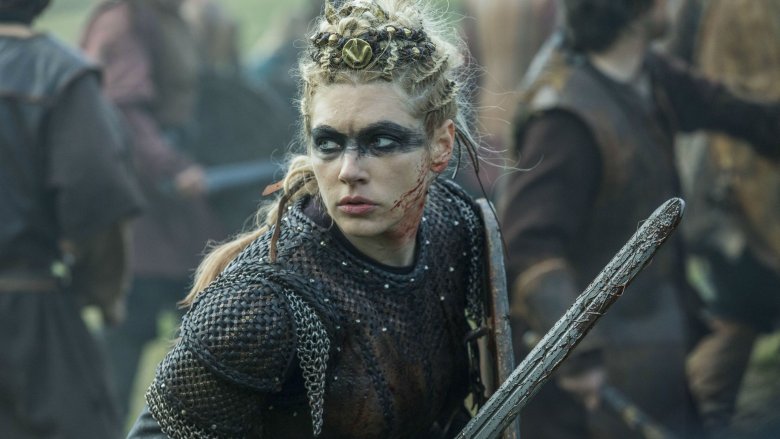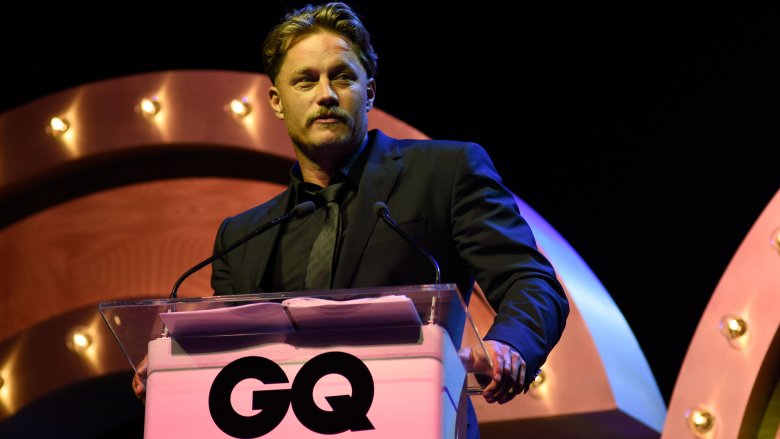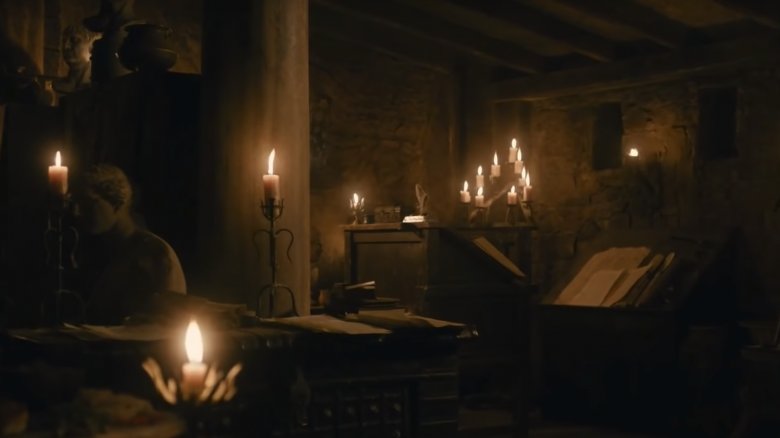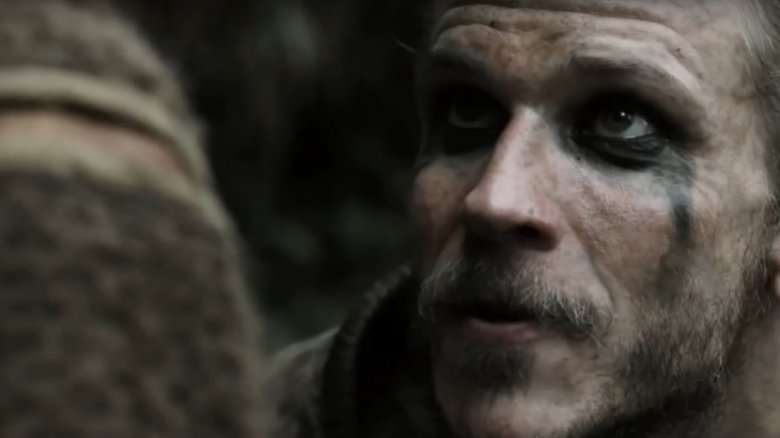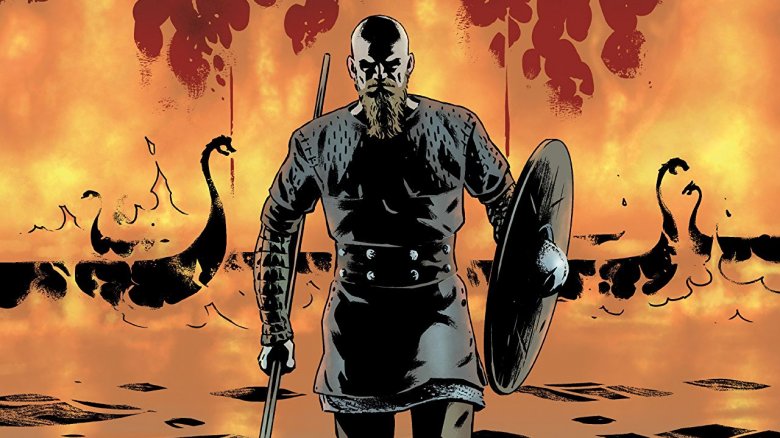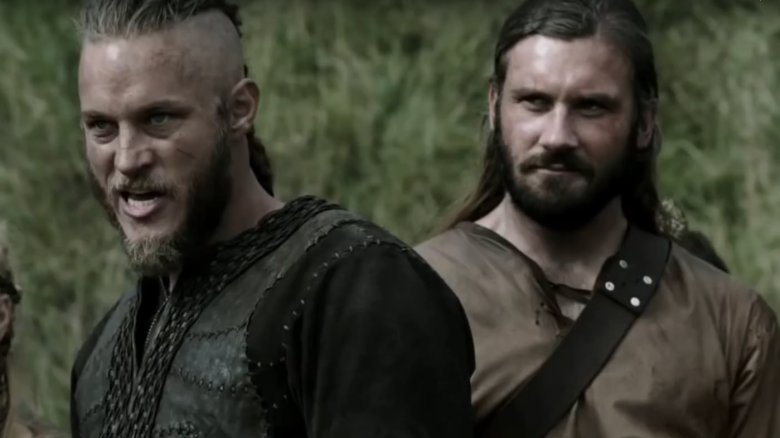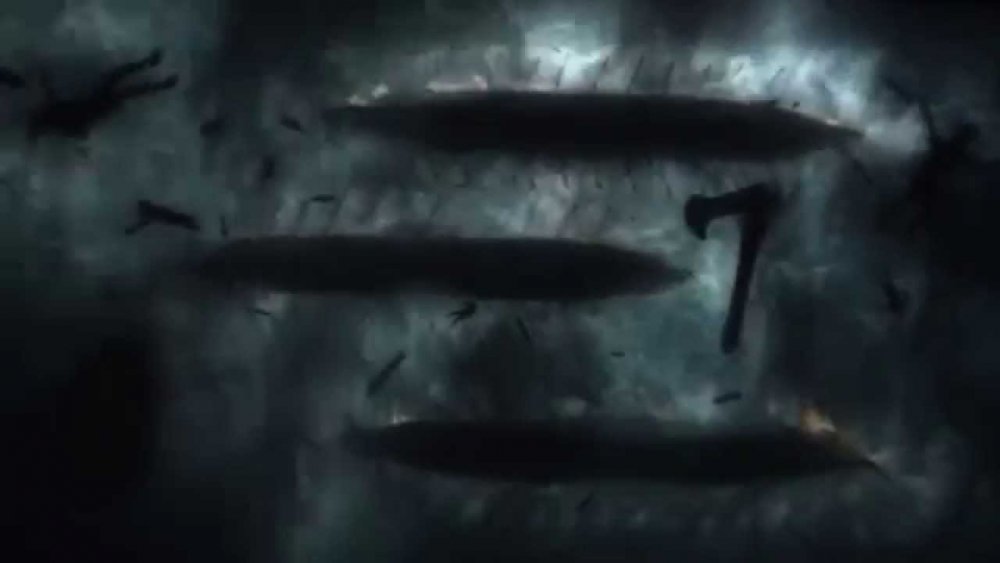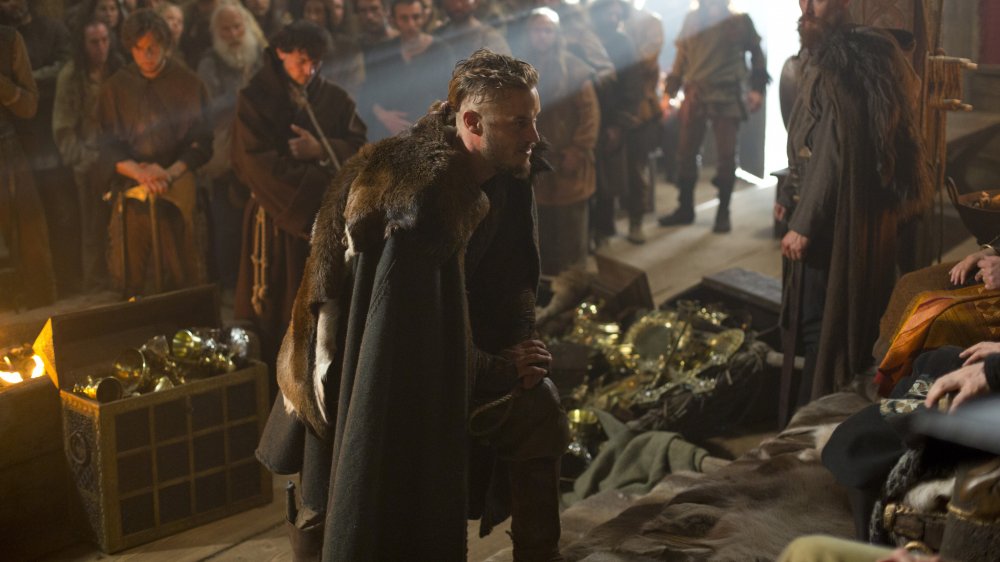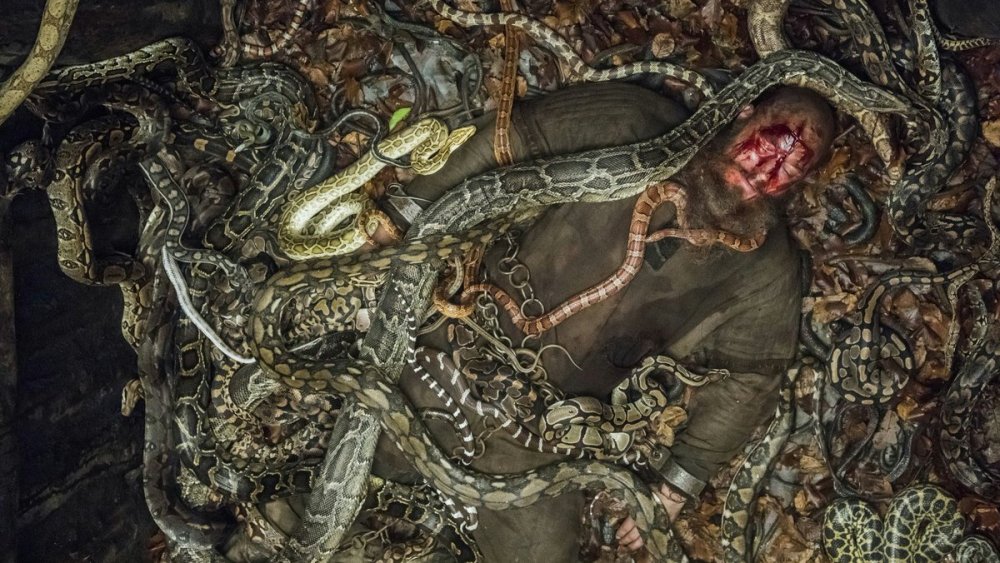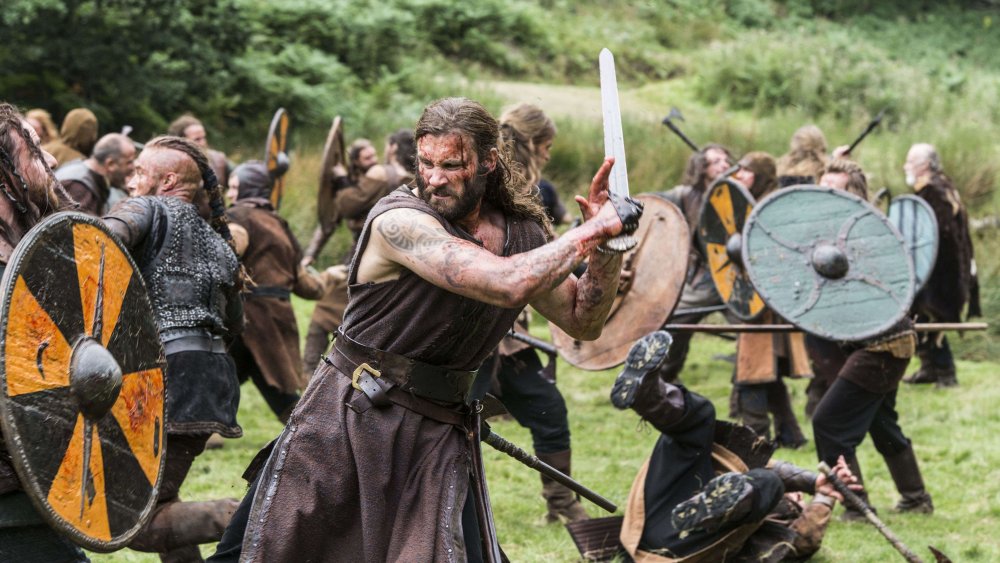The Untold Truth Of Vikings
The vikings and their fiercely unique culture have long been topics of interest for history buffs. But when the History Channel started producing a historical drama that followed the adventures of a band of viking heroes, no one really expected it to turn into the ratings phenomenon it's become.
Swept away by the rising tide of its own popularity, Vikings has grown by leaps and bounds from its original, fairly restrained scope. Initially focused on minimal battle scenes and local politics, the story has morphed into a massive, national, multi-generational epic, all of which centers around or traces back to the deeds of Ragnar Lothbrok and his family, friends, and people.
While the show has successfully upped the ante year after year as far as things like the drama and action go, this historical production has also left a host of other interesting facts and tidbits in its wake as it's gone about making its own spot in television history. This is the untold truth of Vikings.
A brief initial voyage
We're used to watching lots and lots of Vikings at this point, so it might surprise you that the show was originally only supposed to run for a mere nine episodes — a length that The New York Times deemed "ambitious."
The miniseries, which aired in 2013, came on the heels of the History Channel's three-part hit Hatfields & McCoys. Starring Kevin Costner and Bill Paxton, among others, it brought narrative drama and star power to a network that typically aimed more for documentaries and reality TV shows. While not perfect, Hatfields & McCoys showed the network that there could be significant interest in other dramatized miniseries. Equipped with this knowledge and with the younger male, action-oriented gaming crowd largely in mind, History decided to head out in their longships in search of bigger fish. The result? Vikings.
Ragnar Lothbrok is a legit historical character... kind of
Though there is a Ragnar Lothbrok recorded in history, he's recorded as having lived multiple lives. The tales of his ninth-century exploits stretch all over northern Europe from multiple invasions of East Anglia — during which he was killed by being thrown into a snake pit — to adventures as the king of Denmark that include a battle with the Holy Roman Emperor Charlemagne. It's a bit confusing, which is why it was the perfect stomping ground for a historically dramatized show. Nothing is more factually forgiving than a lack of information.
Part of the issue revolves around the severe lack of primary sources, a chronic issue for the region's history. Most of our information on the vikings actually comes from monastic sources writing about raids — in other words, from the perspective of the victims. We do have a handful of other Scandinavian myths that have been passed down through the ages and help round out the picture a little bit. For example, there's the god-infused Elder Edda and the heroic Völsunga Saga. In fact, regarding that latter source, Lothbrok's association with myth is highlighted by the fact that the poem Krákumál, written in the 12th century in Iceland, connected Ragnar directly to the mythic Sigurd, the hero of the Völsunga Saga, via marriage to Sigurd's daughter, who he conceived with the Valkyrie Brunhild.
The show is filmed in the Emerald Isle
Perhaps Vikings' unheralded success can be partly attributed to the luck of the Irish, since a large portion of the filming is done in Ireland. The Island of Destiny has also been the home to numerous other big-budget productions, such as Game of Thrones and Braveheart.
Vikings has definitely made the most of the lush and just plain gorgeous landscapes that the island nation offers. Beyond all that unbelievable natural scenery, the island is simply bubbling over with great places for a film set. Many of the scenes of Ragnar and his loyal followers setting out in their longship, for example, are actually filmed on a manmade lake nestled in the Wicklow Mountains. From Scandinavia to England to France, most of the sites depicted in Vikings ultimately trace their origins back to the Emerald Isle. Even the epic scenes involving medieval Paris are actually filmed on the River Boyne, with the city simply filled in via CGI afterward.
Female power
Katheryn Winnick plays Lagertha, a shield maiden who's never afraid to step into the fray. A strong, independent woman who won't take any crap from her husband, the character offers a reasonably accurate reflection of the history the show draws on for inspiration, especially when compared to the rest of the male-dominated medieval world.
Winnick definitely looks the part, but it isn't just her blonde locks and believably viking demeanor that make her a great fit for Lagertha. Just as importantly, she's a martial arts expert, and we mean that literally — according to her network bio, Winnick holds a third-degree black belt in taekwondo and a second-degree black belt in karate. As if that wasn't impressive enough, she also founded and owned not one, not two, but three different martial arts schools by the age of 21. No wonder those action sequences seem to come to her so naturally!
A shy model and car accidents
Travis Fimmel, who plays the dominant, power-hungry lead role of Ragnar Lothbrok, may have a few things in common with his onscreen counterpart, but they're also very different in some important ways. For example, before he was known as a Viking warlord, Fimmel became famous for causing accidents as a Calvin Klein underwear model.
Fimmel's life has been marked by a meteoric rise from his humble beginnings growing up on a dairy farm in Australia, but it wasn't a seamless transition to acting fame. Fimmel took a bit of a detour in the interim when he stumbled onto a different sort of stardom in the early 2000s as a Calvin Klein model. Despite professing not to put much stake in his own appearance, Fimmel reportedly made enough of an impression with an early billboard that an uptick of car accidents was reported after it went up.
That's pretty flattering, but Fimmel doesn't seem to have loved the gobs of attention he got over his physique, eventually withdrawing into private life before reentering the spotlight as an actor.
Dead languages resurrected
Another fascinating but subtle truth to the show involves the languages being spoken (or sometimes gutturally grumbled) on the set. Those aren't just strange words, they're ancient languages being brought back to life right in front of our eyes. Vikings producers have brought in experts to resurrect languages like Old Norse, Anglo-Saxon (an early pre-English), and even Old Low Franconian (a kind of old French).
The man responsible for the delivery of these tongues is Poll Moussoulides, an Irish-born voice actor proficient in countless European accents. He's been involved in many other productions — including The Tudors and Reign — and is the established linguistic authority on the Vikings set.
Of course, that doesn't mean Moussoulides works alone, or that he's able to translate all those ancient languages on his own. The lines are written for the script and then translated by linguistic historians before Moussoulides takes them to the actors and works with them to ensure that their pronunciations are correct. They each have a week to learn their lines, and it's a hard and fast rule that there can be no last-minute rewriting that would require going through the whole process all over again.
A family affair
Hollywood dynasties are nothing new, but recently we've witnessed the rise of what may be the greatest acting clan to rule them all... and they're not even based in America. The Skarsgård family has been steadily soaking up the limelight for years, first in Sweden and now in America, as one member after another of the talented family tree has made the leap into the acting world.
The head of the family is the renowned Stellan Skarsgård, a face that should be familiar to Marvel fans courtesy of his appearances as Erik Selvig in the Thor franchise and Avengers: Age of Ultron. Stellan has eight children, four of whom have followed their father's lead. Alexander Skarsgård became famous for roles in Big Little Lies and True Blood, Bill Skarsgård recently hit it big when he landed the role of Pennywise in It, Valter Skarsgård has just started his career, and then there's Gustaf Skarsgård, who you'd probably recognize with a little bit more eyeliner on — he's Floki from Vikings.
They're comic book heroes!
The folks at the History Channel took a gamble on a historically based drama with Vikings, and it paid off big time. With that success still going full throttle, it's officially graduated to the next level of cultural impact: being adapted into books and video games.
Multiple comic books have been written around characters based directly on those from the show. In addition to the graphic novels, MGM Interactive and Hugo Games made waves in 2017 when they announced that they were teaming up to release a PVP mobile video game for Android, IOS, and Steam that would be based on the series and in which participants could choose to play as several of the show's most popular characters.
It's got to be a rule out there somewhere that you can't truly claim cinematic fame until someone's created a game with your face in it. The cast of Vikings has arrived.
Who wants to be who, exactly?
When Vikings was just getting off the ground there were some actors who specifically auditioned for various roles, only to end up playing someone else. Clive Standen, for example, eventually ended up playing the role of Ragnar's jealous, muscle-bound brother Rollo, but he initially auditioned for the part of Ragnar Lothbrok himself. In a phone interview with Collider, Stanton explained that he was initially asked to read for the part for Ragnar, but when the decision was made to go with Travis Fimmel instead, he happily accepted the role of Rollo — a character he actually preferred to play.
As it turns out, Fimmel, who's found enormous popularity by playing Ragnar, actually started by auditioning for Floki, played by the talented Gustaf Skarsgård. As Fimmel put it when being interviewed by TheWrap, "I actually wanted to play Floki originally, but the good stuff was already cast... and he did it way better than I could ever do it." Clearly, this is one case when the casting directors could see something the actors didn't — and all these seasons later, it's hard to argue with their decision.
Vikings... and baseball?
In the fourth season of Vikings, the show got a little extra boost of star power when Major League Baseball player Josh Donaldson dropped in for a little cameo appearance. A big fan of the show, the Bringer of Rain got to do what most people only dream of, getting dressed up as a viking and actually getting on the set and in front of the camera.
This isn't the only side gig for the busy MLB superstar, as Donaldson has also shown interest in a part-time MMA career in his free time. Most professional athletes have a good portion of the year that could be categorized as "down time," and it seems Donaldson just doesn't know how to sit still. Perhaps we're witnessing the blooming of an acting career that started in a dugout. Or maybe we're just seeing another facet of the endlessly entertaining world of rabid fandom. Either way, this guest appearance was definitely a hit.
Morbidly sensual folktales
The show has always had a very uncomfortable way of getting under the viewers' skin, often by literally getting under the outer membrane of its own characters. That said, before the narrative-driven violence and gore even has a chance to begin upsetting people's stomachs, the discomfort kicks off in each episode with the haunting opening theme. Less than a minute long, the clip centers on a shipwreck, showing flotsam and jetsam... and highlighting a dead crewmember as they sink below the waves.
The thing is, this isn't just a way to be kind of morbidly artistic. It actually has some original Viking inspiration. In an interview, Director Rama Allen points out that the mood for the intro was initially set to Fever Ray's "If I Had a Heart." They started with the music and worked from there.
Okay, that explains the overall feel, but what about the shots they used? Why the shipwreck? Why the dying sailor? Well, it turns out that the intro is actually based on an old Scandinavian folktale that tells of nine sisters, the "goddesses of the waves," who were known to pluck Vikings right out of their vessels and draw them to a sensual grave. Creepy? Yes. Fitting for a show about warriors obsessed with honor, violence, sex, and an untimely death? Absolutely.
All in from the get-go
When it comes to Vikings, the wealth isn't actually in the ships, it's been behind the scenes.
Many shows boast impressive budgets, and some projects, like Amazon's Lord of the Rings series, are positively swimming in cash. But a show about vikings, and produced by the History Channel no less? Let's just say the series didn't initially scream "big budget."
But that's apparently not what the execs at History thought. They seem to have signed up hook, line, and longboat, right from square one. In fact, according to the Hollywood Reporter, the first season alone was infused with a staggering $40 million budget. That's a serious chunk of change, especially for a show with few recognizable actors that was originally supposed to consist of a quick miniseries about seafaring raiders. Of course, considering the sustained run of popularity and overall success that Vikings has managed to maintain, it appears execs saw something early on and decided to steer into that skid with everything they had — and for that, we're all thankful.
Snake poop
When Vikings is brought up, it inevitably conjures the image of a bearded Travis Fimmel as viking legend Ragnar Lothbrok, plotting, leading raids, and vying for power in one way or another. Of course, Lothbrok's initial story ended in his execution midway through season 4, and the show had to leave him to Valhalla as it moved on with his bickering sons.
While a large group of viking fandom has persistently yearned for a Marvel-esque resurrection of the dead king and a return to glory, the whole "being dropped in a snake pit" is definitely a pretty good indicator that the dude really did meet his demise.
Interestingly enough, it wasn't just Ragnar that got bit by some snakes on that fateful day. It turns out that Fimmel felt some teeth as well. When he was asked if he had any qualms about working with snakes in his final hours as Ragnar, the actor shrugged off the question with an initial "Not really" before following it up with the statement that "I was covered in snake poop at the end. I got bitten a few times, but that was fine — it was them pooping on me that annoyed me more than anything."
Dang. That's some serious berserker posturing right there. You know an actor was cut out to portray a fearsome warlord when they choose to criticize snake poop over a snakebite.
Unfair comparisons
Dudes with swords? Excessive violence? An obsession with sex, treasure, and power? We're talking about Game of Thrones here, right? No? Okay, can we at least compare the two?
Seriously, Vikings has had its fair share of comparisons, but one of the most persistent is the question of whether it holds up when compared to Game of Thrones. After all, the two series aired concurrently and simultaneously portrayed power-hungry families duking it out for dictatorial authority in medieval, northern-European-themed settings. Shouldn't they be compared? Not if one Vikings actor has anything to say about it.
In an interview, Clive Standen, who portrays Rollo, pointed out how much he disapproves of his show being compared to Game of Thrones. Sure, there are similarities, but Standen makes the point that it's comparing uber-violent, ultra bloody apples and oranges. He argues that GoT is fantasy and can lean on elements like dragons while Vikings is tethered, albeit tenuously, to reality and a hardline historical narrative. Considering the significant limitation that this imposes on the show, it really does seem unfair to contrast it to a fictional epic — not that we're comparing.
